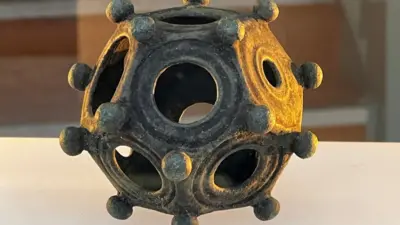We've updated our Privacy and Cookies Policy
We've made some important changes to our Privacy and Cookies Policy and we want you to know what this means for you and your data.
Did the Nazis locate a secret U-boat base in Spain?
- By James Badcock
- Cofete, Spain
Image source, Ramon Perez Niz
Looking up from the wild and barely accessible beach of Cofete, on Fuerteventura's rugged southern tip, it is hard not to wonder who would have built a house high up on the hillside.
According to some, the remote location of the building known as Casa Winter is not explained by its fine views over a landscape that now forms part of Jandia natural park, but something far more sinister: the presence of Nazis in the Canary Islands during World War Two.
"There is so much to investigate here, but no-one is helping me," says an exasperated Pedro Fumero, the current occupant of Casa Winter who believes he may be sleeping on top of a secret base or hideaway designed for use by the Nazis.
The 48-year-old former taxi driver, whose grandfather helped to build the house and later lived in it, moved into the building in 2012, having found out that his two uncles and an aunt were inhabiting the place in poor health and squalid conditions.
The family is facing an eviction order after a hotel company bought the property from the descendants of Gustav Winter, a German engineer whose unusual wartime activities on Fuerteventura attracted the attention of Allied spies.
Winter, who was born in the Black Forest region in 1893 and moved to the Canary Islands in 1925, was one of 104 German residents in Spain whom Allies requested be repatriated to Germany at the end of WW2 to face accusations of being Nazi agents.
A 1947 document on these Nazi suspects from the Madrid bureau chief of the US Office of Strategic Services, a precursor of the CIA, describes Winter as a radio operator and military operator.
Image source, OSS
Like other Germans on the list of suspected Nazis whom the Allies had wanted to question and put on trial after the war, Winter was not handed over by the Spanish authorities. He died in Las Palmas de Gran Canaria in 1971.
"I am sure Gustav Winter was provisioning German submarines," states Mr Fumero, citing wartime reports and some of his own findings, such as a battery he says is from a U-boat and that he found in the property.
"Why would you build a tower like this on top of what is essentially a bunker? This was never a house meant for enjoyment," says Mr Fumero, standing inside the turret-like construction that dominates the upper level of Casa Winter, equipped with an unusually large fuse box.
Image source, Getty Images
Could the tower have been used for communications? Or even as a kind of lighthouse, sending messages through electric flashes? Local historians mostly conclude that Cofete's beach would have been unsuitable for naval use due to its shallow approach, but also point out that the natural harbour of Ajuy, 20 miles (32km) along Fuerteventura's remote east coast, could have been used by submarines or other large craft.
The biggest spaces inside the building are in the solid basement, whose walls are almost 2m (6ft 7in) thick. Several rooms have no windows, including one tunnel-like space which runs the length of the house with just a small window at one end. Mr Fumero speculates that such spaces could have been used for concealing people - with or without their consent - but admits that he cannot be sure who or when.
Local documents date the house as being built in 1946, but Mr Fumero claims the "bunker" or base of the building was there much earlier, pointing to papers he believes show that Winter had bought out the previous Spanish landowner and acquired the entire Jandia peninsula shortly after General Franco had become Spain's dictatorial ruler in 1939.
Under Franco, Spain declared itself to be strictly neutral at the outbreak of WW2, but supplied minerals, volunteer soldiers and, in places such as the Canary Islands, logistical support to Nazi forces.
U-boats and Spain in World War Two
Image source, Hulton Archive/Getty
The "U-boat peril", as Winston Churchill described German submarine power, was a huge threat to Britain's survival during the early stages of World War Two.
U-boats, supplemented by mines, aircraft and surface ships, succeeded in sinking three million tons of Allied shipping between the fall of France in June 1940 and the end of that year.
At the outbreak of WW2 in 1939, Spain was a broken country after the conclusion of its three-year civil war. General Francisco Franco wished to avoid dragging Spain into WW2, but his regime owed a large debt of gratitude, in material and other terms, to fascist Germany and Italy.
Spain was officially neutral, but unofficially on the Axis powers' side. And Spanish ports became important refuelling and provisioning sites for roving U-boats between 1940 and 1942.
Alberto Vazquez-Figueroa, a writer from the Canary Islands in whose novel Fuerteventura Casa Winter is fictionalised as a kind of Nazi pleasure palace, says that islanders were kept out of the southern peninsula until the 1950s, when the Franco regime finally removed a fence which crossed the spit of land from coast to coast. "Word was that Franco had ceded that part of the island to the Germans and they had built a small airstrip there."
Winter built an airstrip in the barren, rock-strewn stretch of land between Cofete beach and his curious mansion, the remains of which are still evident to walkers and whose parallel lines of stones are visible in Google satellite pictures of the coast.
"I was told by one of his sons that it was because Winter's wife had a difficult birth experience, so he decided that planes should get access," says Juan Jose Diaz Benitez, a history lecturer at the University of Las Palmas de Gran Canaria, who has researched the story.
Dr Diaz Benitez believes that Winter used connections with the Nazi authorities in the 1930s to secure investment for the building of the harbour at Morro Jable and a plan to electrify the island of Fuerteventura and build a cement factory. Diaz Benitez cites a wartime letter from a German official to Luftwaffe chief Hermann Goering "complaining that it was rumoured in the Canaries that one Gustavo Winter was supplying fuel to German submarines, and that this was attracting the attention of enemy spies".
"The only thing proven by German documents is the subsidies he got for economic plans for island of Fuerteventura," Dr Diaz Benitez argues.
Image source, Ramon Perez Niz
The presence of German submarines in the Canaries archipelago during the conflict is an established historical fact.
Dr Diaz Benitez says that besides the frequent use of local ports by tanker ships that would rendezvous with U-boats at distant, secret locations, German submarines docked at Las Palmas six times between May and July of 1941, prompting an official complaint by an exasperated British consul on the island of Gran Canaria.
Image source, Pedro Fumero
For now, Mr Fumero's worries relate to the future of the house. But Lopesan, the company that now owns Casa Winter, told the BBC that it did not intend to develop the site as a resort, but rather "turn it into an interpretation centre".
"There are signs that this may have been a historically important and strategic site. We won't be developing the area around the house, but only restoring the building," Lopesan said.
Mr Fumero believes there is more to come from below the surface, literally. He says that he has asked a ground-penetrating radar company to prospect below Casa Winter, which he believes stands on a natural cave, a volcanic fissure which could be connected via a tunnel to the sea.
"It's not comfortable living out here. I left my family on Tenerife; I had a partner, but she couldn't take this remoteness. But now I am on a mission to uncover the truth about the house," he says.
Top Stories
Features & Analysis
Most read
Content is not available








